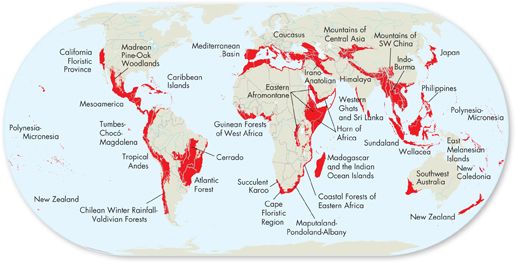
FIGURE 6–20 Ecological Hot Spots Conservation International identifies biodiversity hot spots using two criteria. The area (1) must contain at least 1500 species of native vascular plants, and (2) it must have lost at least 70 percent of its original habitat. The 34 hot spots seen here cover just 2.3 percent of Earth's land surface, but they contain over 50 percent of the world's plant species and 42 percent of its terrestrial vertebrates.
The challenge is protecting areas that are large enough and that contain the right resources to protect biodiversity. To make sure that conservation efforts are concentrated in the most important places, conservation biologists have identified ecological “hot spots,” shown in red in Figure 6–20. An ecological hot spot is a place where significant numbers of species and habitats are in immediate danger of extinction. By identifying these areas, ecologists hope that scientists and governments can better target their efforts to save as many species as possible.
Considering Local Interests Protecting biodiversity often demands that individuals change their habits or the way they earn their living. In these cases it is helpful to offer some reward or incentive to the people or communities involved. The United States government, for example, has offered tax credits to people who've installed solar panels or bought hybrid cars. Similarly, many communities in Africa, Central America, and Southeast Asia have set aside land for national parks and nature reserves, like the park shown in Figure 6–21, to attract tourist dollars. In some Australian communities, farmers were paid to plant trees along rivers and streams as part of wildlife corridors connecting forest fragments. Not only did the trees help improve local water quality; they also improved the health of the farmers' cows, which were able to enjoy shade on hot days!
The use of carbon credits is one strategy aimed at encouraging industries to cut fossil fuels use. Companies are allowed to release a certain amount of carbon into the environment. Any unused carbon may be sold back at a set market value or traded to other companies. This strategy encourages industries to pay for lower-emission machinery and to adopt carbon-saving practices. In this way, pollution is capped or cut without adding a financial burden to the industry involved. This helps protect the economy while reducing biodiversity loss due to pollution. These examples show that conservation efforts work best when they are both informed by solid scientific information and benefit the communities affected by them.

FIGURE 6–21 Ecotourism A tourist gets an elephant-size kiss from one of the over 30 rescued elephants at Thailand's Elephant Nature Park.
Table of Contents
- Formulas and Equations
- Applying Formulas and Equations
- Mean, Median, and Mode
- Estimation
- Using Measurements in Calculations
- Effects of Measurement Errors
- Accuracy
- Precision
- Comparing Accuracy and Precision
- Significant Figures
- Calculating With Significant Figures
- Scientific Notation
- Calculating With Scientific Notation
- Dimensional Analysis
- Applying Dimensional Analysis




